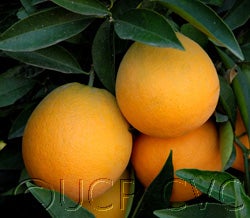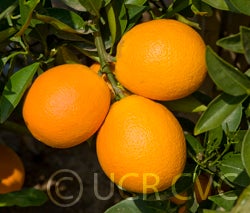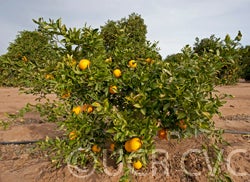Citrus sinensis L. Osbeck
CRC 4192
VI 582
Source
Received as budwood from Transvaal, South Africa, 2006. Discovered as a 30-year old tree by Mr. Koos Kotze at Gillemberg Estate (Burdette et al., 1995; Saunt, 2000).
Parentage/origins
Most probably a limb sport of 'Palmer' navel (Burdette et al., 1995; Saunt, 2000).
Rootstocks of accession
Carrizo citrange, C-35 citrange
Season of ripeness at Riverside
November to January
Notes and observations
RRK: 'Gillemberg' navel matures 4 - 6 weeks after 'Palmer' and hangs well on the tree. The fruit is medium to large in size (larger than 'Palmer'), round to oblong in shape, with a pebbly, sometimes coarse rind, and a Palmer-like tight navel end. Fruit quality and yield on the parent tree is excellent. The foliage is denser and the leaves more tapered than 'Palmer'. (Description condensed from Burdette, 1995, and Saunt, 2000.)
In South Africa, 'Gillemberg' was multiplied starting in 1987 and was later shoot-tip-grafted and propagative material distributed through Outspan. Growers were encouraged to plant 'Gillemberg' on a "semi-commercial scale" in the Cape areas (Burdette et al, 1995). According to Burdette et al. (1995), rootstock choices for 'Gillemberg' would probably be the same as for 'Parent Washington' and 'Palmer'. Saunt (2000) further notes that 'Gillemberg' "has outstanding flavour even when grown on rough lemon rootstock in the cooler citrus-producing areas in South Africa."
Availability
Commercially available in California through the Citrus Clonal Protection Program. Click here to order budwood.
USDA Germplasm Resources Information Network page for Gillemberg navel orange
Bibliography
Burdette, SA, CJ Alexander, ATC Lee, E Rabe. 1995. Features of some of the main citrus cultivars of southern Africa. Citrus Journal, 5(1):15-21.
Saunt, J. 2000. Citrus Varieties Of The World, 2nd ed. Sinclair Intl., Norwich, England.



